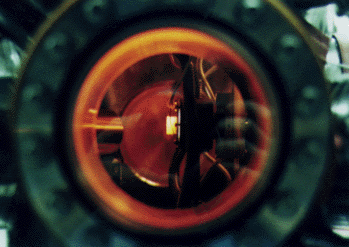|
Since chlorofluorocarbons are used in industry as refrigerants and are sold to the public in products such as aerosol cans, the theories that have been proposed have come under considerable scrutiny. There is a need to investigate these theories in complete detail, so that a solution that is scientifically valid may be formulated.
Theories advanced by atmospheric scientists rely on many reactions taking place in order for the chlorofluorocarbons to destroy the ozone layer. This work investigated the role of heterogeneous reactions in the destruction of ozone in the stratosphere. Specifically, we investigate the reaction of hydrogen chloride (HCl) and solid water (ice).
Normally ozone is continually created and destroyed via the following
reactions:
O2 + hv --> O + O
O + O2 --> O3
O3 + hv --> O2 + O
These reactions take place about 40 kilometers above the earth in the
stratosphere.
It is theorized that the CFC's rise into
the upper atmosphere where they are photolyzed to produce another CFC and
a chlorine free radical (Zurer 1993). One such reaction is:
CCl2F2 (CFC-12) + hv --> CClF2 + Cl
Free chlorine radicals act as catalysts which deplete the population of
O3 molecules available for the reaction 1.3 by the process:
Cl + O3 --> ClO + O2
ClO + O --> Cl + O2
O3 + O --> 2O2 (net)
Because the chlorine radical is regenerated in this process, it
is available to destroy many other O3 molecules by the same process.
One cycle that atmospheric scientists are particularly interested in understanding is the seasonal ozone depletion above the Antarctic. The Antarctic is an interesting system to study because it has suffered extensive damage, i.e. the well publicized ozone ``hole''. Additionally, in the winter, it becomes a closed system. During this season, the winds begin to circle above the polar region, creating what is called a polar vortex. The winds of the polar vortex region do not mix with the rest of the atmosphere until late spring.
The mechanism described in equation 1.5 does not explain the destruction of the ozone layer above the Antarctic for two reasons. First, it does not provide for a seasonal depletion of ozone as is observed above the Antarctic. Secondly, there are not enough O atoms present in the altitudes in which the most prominent destruction has occurred. In fact, these reactions have been shown to be insignificant at 40 km, stratospheric altitudes (Zurer 1993). Therefore another theory has to be considered.
The theory that accounts for seasonal depletion of ozone takes into account the reservoir species. These species are nodes in holding reactions. These reactions compete with ozone destroying mechanisms and have the effect of removing destructive species from the ozone cycle ( Wayne, Chemistry of Atmospheres 1991).The most prominent of these reservoir species is hydrogen chloride, HCl, which accounts for about 70 percent of atmospheric Cl.
To introduce a seasonal cycle, a mechanism is needed to explain how these reservoir species are converted into species active in for ozone destruction. It is proposed that HCl and ClONO2 react on the surface of polar stratospheric ice particles in the clouds and produce molecular chlorine (Cl2) and hypochlorous acid (HOCl). (Tolbert, Science 240, 1988).
| 
 HCl/Ice
HCl/Ice N2 scattering from ice
N2 scattering from ice H2 scattering from ice
H2 scattering from ice![]() Michelle Gotthold and GOS, Inelastic scattering of N2 from water ice, J. Phys. Chem. A 102 (1998) pp 9557-9564.
Michelle Gotthold and GOS, Inelastic scattering of N2 from water ice, J. Phys. Chem. A 102 (1998) pp 9557-9564.